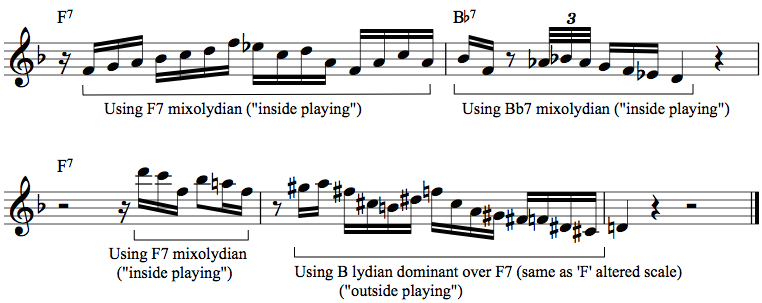Playing outside the chord changes is a technique that gives jazz and funk improvisers that advanced, pro sound. In this article, I’m going to give you an inside look at outside playing.
In the jazz/funk improvisational world, “outside” playing refers to the idea of using a scale (or collection of notes) for improvisation that is seemingly unrelated to the given chord. An example of “outside” playing might be a soloist selecting notes for his solo that shouldn’t fit with the chord over which he is soloing, and yet the result sounds… kinda awesome. We use the term “outside” playing as a contrast to what we might call “inside” playing, which is the conventional approach of using chords and scales which have obvious relationships to one another.
There are many approaches to “outside” playing, but the one that we’re going to examine here relates to tritone substitution. For more information on exactly what tritone substitution is and a comprehensive explanation of how it works, check out my article entitled “Tritone Substitutions Demystified.” In short, tritone substitution allows you to substitute one dominant 7th chord for another dominant 7th chord a tritone away. (A tritone is the interval of an augmented 4th or diminished 5th). If we are comping over an F7 chord, we can instead choose to play a B7 chord, the tritone sub (F7 and B7 are both dominant chords and are a tritone apart from one another).
Comping, however, is not the only application for tritone substitution. We can also use tritone substitution in our improvisational playing. If we are improvising over an F7 chord in an ‘F’ blues, we may use a scale such as the F mixolydian scale which contains the following notes:
F = root, G = 9th, A = 3rd, Bb = 4th/11th, C = 5th, D = 13th, Eb = flat 7th.
This will give our solo that “inside” sound because the F mixolydian scale and the F7 chord are very closely related to one another. But what if we instead used a scale centered around B7 in our improvisational playing and played that over F7? Let’s use a scale that is sometimes referred to as the “lydian dominant” scale, starting on B. The “lydian dominant” scale is simply a B mixolydian scale with a #11. Here it is spelled out:
B = root, C# = 9th, D# = 3rd, E# (F) = #11, F# = 5th, G# = 13th, A = flat 7th.
But now, consider what these notes of the B lydian dominant scale would be in relation to F7:
E#/F = root, F# = flat 9th, G# = sharp 9th, A = 3rd, B = #11, C# = flat 13th, D# = flat 7th.
By superimposing the notes of the ‘B’ lydian dominant scale over F7, we are able to get some of that “outside the changes” sound that is so pro, so advanced, and so hip! By using “outside” notes we stretch the relationship between the chord and the scale and build tension in the solo, seemingly taking it “outside” of F7 (even though we know F7 and B7 are related).
Take a listen to the example solo below, which uses a B lydian scale over an F7 chord in measure 4. Then get some practice using tritone subs to create “outside” playing in your own solos!


